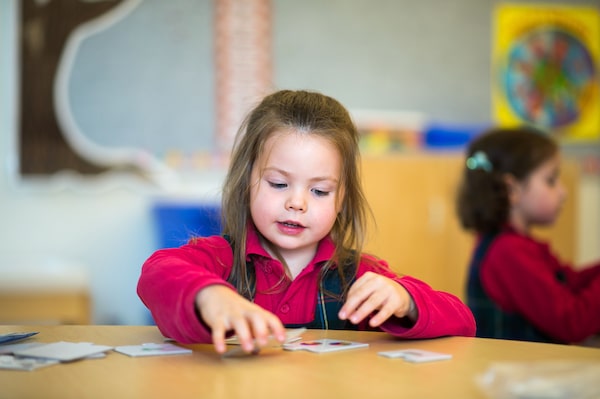
Students work with teachers and specialists in math classes at St. Margaret's School in Victoria, British Columbia.James MacDonald/The Globe and Mail
Preliminary research on the effect of school closures during the pandemic shows that primary school students likely made little or no progress during periods of remote learning. The impact of this delay on students’ math performance is a particular concern for parents, kids and teachers returning to school this year.
While it is generally understood that education suffered when schools flipped to remote learning, research on the impact of the disruption is still ongoing, which means math researchers and educators have limited data to work with as they discover how students have fared with retaining their lessons.
The study, conducted in the Netherlands, showed children experience 5.6 weeks of learning delay for every eight weeks of school closure, despite equitable school funding and high access to broadband internet. For provinces like Ontario, where students missed 20 weeks of in-person learning between March 2020 and May 2021, these findings indicate that kids in both public and private schools could be starting the year with significant gaps in learning compared to previous years.
Megan Hedderick, director of academic programs and innovation at St. Margaret’s School, an all-girls private school in Victoria, B.C., says a math specialist at the school saw a pattern in attitudes towards the subject throughout the pandemic.
“Parents were anxious that their kids would get behind with math because of remote learning, so that led to parents wanting kids to get tutored, which unintentionally puts pressure on students and leads to more anxiety,” Hedderick says.
The school has hired three new math teachers over the last year, not in response to a dip in grades, but to help meet the demand for an in-depth math program that goes beyond rote learning.
Dr. Lynda Colgan, a professor who has taught math at all levels from elementary school to graduate school, says it’s common for students to worry about their math education.

St. Margaret’s School in Victoria, B.C., has hired three new math teachers over the last year, not in response to a dip in grades, but to help meet the demand for an in-depth math program that goes beyond rote learning.James MacDonald/The Globe and Mail
“Especially in math, kids are often concerned that they’ve forgotten everything they knew, or that the work is going to be too hard for them,” says Colgan. “That anxiety is very real.”
Throughout the pandemic, Colgan heard from parent groups requesting testing to assess their child’s math comprehension.
“There’s a fear that having missed school, their future is going to be compromised and they won’t be successful, especially as they make transitions, like from elementary to high school,” she says.
However, parents and schools have little at their disposal when it comes to assessing a child’s math comprehension.
“There are no reliable instruments in place, so a teacher isn’t able to just give a test to their kids and find out who is operating at grade level. It’s highly problematic,” Colgan says.
A research team at Carleton University Math Lab is currently piloting one such instrument — a tool to help assess math understanding for children from Grade 1 to Grade 3. However, compared to literacy assessment tools, researchers say tools for math assessment are decades overdue.
“We’ve had literacy research for the last 50 years. In math research, we’re behind. It’s definitely an area that needs to be investigated,” says Dr. Sandy Youmans, an adjunct assistant professor at Queen’s University with expertise in kindergarten, numeracy and self regulation in education.
“Early math skills are the greatest predictor of future math and school success across all subjects, even more than literacy.”
One of the keys to overcoming the gaps in math learning, Colgan and Youmans agree, is for educators to adopt a social-emotional approach to teaching the subject. This teaching style focuses on building a student’s resilience by encouraging them to work through challenging emotions while they learn.
Ontario made strides towards this approach with a 2020 curriculum change, but Colgan says she’s disappointed to see poor adoption — something she attributes to limited resources for new textbooks, or professional development for public educators. This is where Colgan says private institutions may have an advantage in helping their students get back on track.
“There are more funds for providing resources, and there typically is more opportunity for teachers to attend conferences. The fact that they can attend means they’re learning from leading people in the field. Very few educators in public systems ever get funded to attend conferences.”
Smaller schools, like the 300-student Rothesay Netherwood School located in a suburb of Saint John, New Brunswick, are also able to more nimbly experiment with new approaches to learning. They’ve taken a collaborative approach to math tutoring.
“Math is different from every other subject, and it’s where our students most often look for help,” says Craig Jollymore, assistant head of school and director of academics at the school.
“We have a peer tutoring program, where our best kids come in and do three hours of extra learning with day students and boarders. It’s really powerful.”
Collaboration is a core part of the social-emotional approach to math, where kids are encouraged to talk through emotions that come up as they work through problems. Chiefly, this helps diffuse anxiety around making mistakes.
“Before we can address the content gaps, we have to build academic resilience and instil positive attitudes in ourselves as educators, and in our students and parents,” Colgan says.
Looking for more stories about private school education? Get the latest on curriculum trends, financial assistance and the pandemic’s impact here.